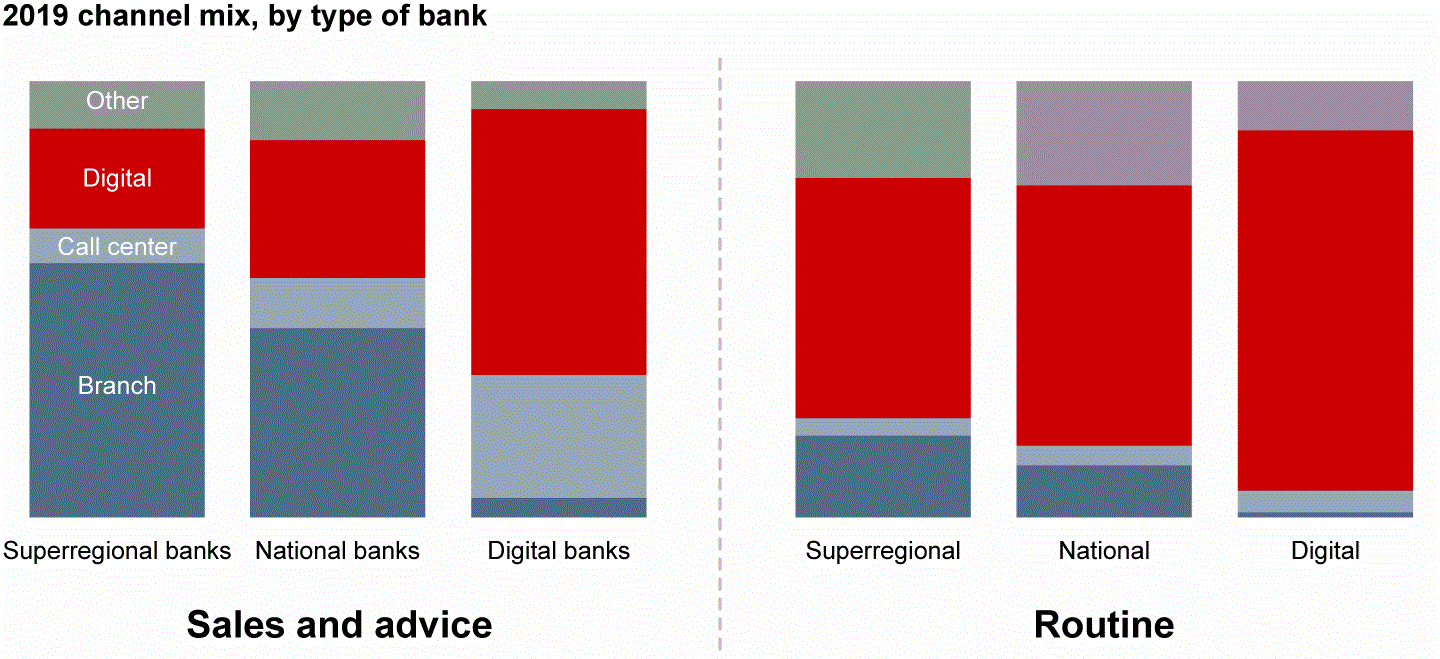All Aboard: Why Every Bank Needs Omnichannel
~6 min read

Consumer banking is sometimes seen as a zero-sum game. As banking goes ever-more digital, it’s perhaps natural to think that those who provide the right services through the right channels, with the best user experience and at the most competitive rates, will take the consumer banking crown. But as 2020’s acceleration of the digital transformation process has revealed, there’s plenty of room in the market for players of different sizes and types to corner their respective niches -- as long as they invest in the right digital tools. Megabanks, credit unions, community banks, and digital-first challengers alike are facing a market where consumers expect efficient digital processes, and while providers of all types can still expect a seat at the table, COVID has made sure that in 2020, investment in digital transformation went from important to non-negotiable.
Transform '21
Digital transformation is much-discussed as a force of change in finance, but what does it mean, in practice, for banks to invest in digital? The traditional paradigm for digital transformation demarcates three approaches. The first is front-end digitization, which focuses on digitizing everywhere that customers interact with the bank while maintaining legacy infrastructure intact. The second, so-called “wrap and digitize” approach, creates a digital front-end for customers to interact with while also gradually replacing legacy systems with digital ones. In the meantime, APIs and other integration measures are put in place to grant access to data from across the institution. Finally, the “digital native” approach consists of creating a digital bank from the ground up, with a flexible, possibly cloud-based architecture offering end-to-end digital processes for customers.
The last year, however, has changed the math on digital transformation. According to a Deloitte study of 39 countries, 60% of banks closed or shortened branch hours in response to the COVID-19 pandemic. To continue serving customers who were sheltered-in-place, financial institutions supercharged their adoption of digital channels for everything from account opening to payments and check deposits.
But the changes necessitated by COVID-19 went beyond a front-end facelift for customer-facing applications. Banks, like many other organizations, had to “virtualize overnight”, in some cases transitioning many tens of thousands of employees to a remote work model -- a change which requires an enabling digital infrastructure. And now that the remote work model has proven effective in financial services (with 69% of companies embracing at least partial work-from-home model going forward, according to a recent survey), greater investment in digital solutions to ensure security and access for remote financial services workers is likely to follow.
Early Dividends
For financial institutions who’ve already digitized significantly in recent years, the investment has already begun to pay dividends. The speed and efficiency of digital processes leads to improvements across many essential banking KPIs -- from higher application completion and conversion rates to faster handling of issues and better customer retention. Cost-to-serve is also dramatically lower for digital transactions on average; by some calculations, mobile and online transactions only cost a bank about $0.10 and $0.19, respectively, while transactions handled via call center cost about $1.30 each to execute, and branch transactions can cost a bank as much as $4.25.
Importantly, digital transformation is not about turning cost-ineffective branch transactions into cost-effective digital ones; it’s about offering customers the ability to transact how they want, when they want, with as little hassle as possible. Whether a customer transacts online or in-branch depends on a few factors: the type of transaction; the customer’s comfort level with mobile and online banking; or the proximity and convenience of visiting a branch -- to name just a few. And while banks that create efficient digital channels (and effectively communicate their respective value propositions to customers) may be able to effect some cost-saving channel migration, as the balance of transactions across the industry is shifting toward digital anyway:

Source: Bain & Company
According to a Bain & Co. report, in the U.S., pre-pandemic, “virtually all banks have moved the majority of routine transactions to digital, [but] only a few have successfully converted complex interactions involving sales or advice”. In other words, the transaction mix for digital channels was skewed towards basic processes like payments and account balance monitoring, while customers often still preferred to conduct complex transactions in-person.
Then, during the pandemic, more than half of bank customers reported using digital banking tools more often (according to a BAI survey), and a follow-up in August 2020 revealed that the shift is likely not temporary, with 87% of respondents reporting increased digital usage, and saying that they would maintain it after banks resume regular in-person banking. In addition, the proportion of customers who said they would prefer to conduct complex transactions in-person, with a banker (rather than over the phone or online), decreased between January and August 2020. These included select transactions like loan applications, deposit account openings, and advisory services, suggesting that the pandemic may have boosted digital adoption for even the most stubborn transactions.
The New Kids
While investing in digital channels and a digital back office is more important than ever, banks may also unlock additional value through fintech partnerships. Fintechs love to partner with banks because it gives them exposure to a large customer base in addition to the legitimacy that comes with being endorsed by an established institution. Banks, on the other hand, partner with fintechs in order to bring new features and functionality to their customers more swiftly.
At a time when most customers expect a seamless digital experience for routine transactions at a minimum (and, increasingly, for complex transactions) a fintech partnership can modernize a bank’s overall portfolio of offerings in a hurry. Furthermore, banks may find their relationship with customers improved by adopting a marketplace approach - that is, by partnering with multiple fintechs to create an ecosystem of services that customers access through their main bank. With this approach, customers get the best of both worlds: they keep their main bank account, which may offer superior branch and ATM access or other desirable attributes, while enjoying sophisticated fintech-powered services common to the Neobank space.
Digital-only banks - also known as Direct Banks, Challenger Banks, or Neobanks - spent 2020 regrouping, from N26’s exit from the UK to Monzo and Revolut both posting more than £100m in net losses for the year. Starling Bank, meanwhile, became the first Neobank to turn a profit, bringing in £9m of revenue and £0.8m in profit in the month of October. According to Starling, this is a four-fold increase in revenue for the bank relative to one year ago; customer accounts almost doubled in that time, and operating costs only increased 30%. While modest, these figures represent a path forward for Neobanks, who can service a large number of customers on relatively low overhead.
Starling’s case may prove what some observers have noted: that what works in banking will also work in digital banking. Banks make more revenue from interest on loans than they do from fees on deposits, and without a healthy loan portfolio, Neobanks lack the foundation enjoyed by incumbent banks. The absence of profit is common within the tech industry, and investors are often happy to continue funding unprofitable tech firms as long as they show growth and market share, but this attitude may not be compatible with banking. With the retail banking industry already greatly fragmented and well-funded incumbents, regional players, and even finance-minded tech companies themselves rapidly digitizing the space, explosive growth in the footsteps of Uber or Airbnb will be hard to come by. A flatter growth curve, the right features, and a keen sense of customer needs (and cost) are likely a more successful formula given the already-crowded marketplace.
No matter what happens in 2021, banking will continue to digitize. From routine transactions and account opening to advisory services and cross-selling of products, 2020 proved that the digital frontier is more than possible -- it’s inevitable. What does that mean for banks? Hurry up and find out what customers want. What does it mean for customers? Hurry up and download your bank’s app, or apply for a secondary account at a Neobank depending on which features you want. And finally, what does it mean for the industry? Presumably, a fragmented market with distinct customer segments and enough room for players of all types and sizes -- as long as they’re ready to go digital.
Image courtesy of Omar Prestwich
Click here to subscribe and receive a weekly Mondato Insight directly to your inbox.

Innovations in Insurtech: Observing Fintech’s Path While Forging Its Own
Travel Rewards: A Currency Out Of Context